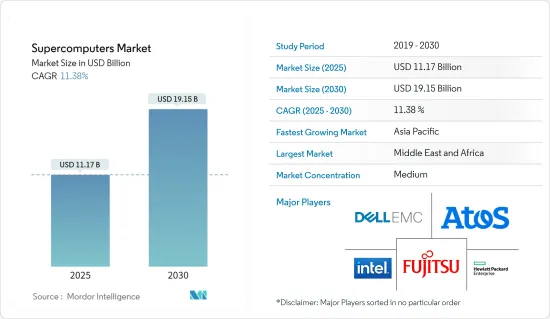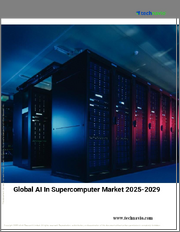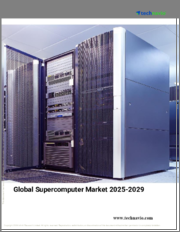
|
시장보고서
상품코드
1687334
슈퍼컴퓨터 시장 : 시장 점유율 분석, 산업 동향 및 통계, 성장 예측(2025-2030년)Supercomputers - Market Share Analysis, Industry Trends & Statistics, Growth Forecasts (2025 - 2030) |
||||||
슈퍼컴퓨터 시장 규모는 2025년에 111억 7,000만 달러로 추정되고, 예측 기간인 2025-2030년 CAGR 11.38%로 성장할 전망이며, 2030년에는 191억 5,000만 달러에 달할 것으로 예측됩니다.

고성능 처리 능력을 갖춘 슈퍼컴퓨터는 인공지능(AI) 프로그램을 실행하기 위한 핵심기기로서 점점 더 존재감을 늘리고 있습니다. 그 아키텍처는 AI 및 머신러닝 애플리케이션의 방대한 데이터 요구 사항을 처리하는 데 능숙합니다.
고성능 컴퓨팅(HPC) 애플리케이션의 세계 활용 확대가 시장을 견인
주요 하이라이트
- 방대한 컴퓨팅 능력과 속도로 알려진 슈퍼컴퓨터는 고성능 컴퓨팅(HPC) 시스템에서 중요한 역할을 하고 있습니다. 그 성능으로부터, HPC 분야에서는 빼놓을 수 없는 존재가 되고 있습니다. 과학 연구가 시뮬레이션 기반 기술로 기울고 머신러닝(ML)의 중요성이 높아지면서 슈퍼컴퓨터에 대한 시장 수요는 현저히 증가하고 있습니다.
- 게다가 2024년 10월, NVIDIA의 주가는 최신의 슈퍼컴퓨팅용 AI칩 'Blackwell'의 왕성한 수요에 대한 낙관적인 견해의 고조에 추진되어 사상 최고치를 갱신했습니다. 이는 슈퍼컴퓨터의 유망한 성장 궤도를 강조하여 시장 전체의 확대를 뒷받침하고 있습니다.
- 조직이 복잡한 데이터세트 및 분석 워크로드에 종사함에 따라 슈퍼컴퓨터 수요는 높아질 것으로 보입니다. 슈퍼 컴퓨터는 교육 연구 기관에 보다 친숙하고 비용 대비 효과가 높은 것이 되고 있습니다. 게다가 특히 클라우드 컴퓨팅에 대응한 Platform-as-Service 모델을 통해 컴퓨팅 파워를 민주화하는 경향이 강해지고 있는 것도 시장을 더욱 끌어올리는 요인이 되고 있습니다.
슈퍼 컴퓨팅 시스템의 높은 초기 비용이 시장 성장의 주요 억제요인
주요 하이라이트
- 장치의 가격, 하우징 인프라, 운영비용을 포함한 소유비용이 높아 슈퍼컴퓨터를 고가로 하고 시장성장의 장애가 되고 있습니다. 예를 들어 2024년 3월 마이크로소프트와 오픈AI는 약 1,000억 달러의 AI 기반 슈퍼컴퓨터를 공동으로 구축했습니다. 이는 이러한 슈퍼컴퓨터가 주로 대기업용이며 중소기업에는 실현 불가능하다는 것을 보여줍니다.
각국 간의 지정학적 갈등이 시장 성장에 영향을 미칠 가능성
주요 하이라이트
- 사이버 방위 및 공격을 강화하기 위한 방위 부문에서의 스파콘 수요가 정부 부문 시장 성장을 지지하고 있습니다. 게다가 2024년 4월 미국 국무부 사이버보안 담당자가 비정상적인 활동을 탐지해 중국이 양자 슈퍼컴퓨터를 개발한 것으로 밝혀졌습니다. 이 진화는 서구 암호를 모두 파괴할 수 있으며, 이를 통해 사이버 방위를 무효화할 수 있습니다.
슈퍼컴퓨터 시장 동향
상업 산업이 가장 큰 최종 사용자에게
- 자동차 회사는 업무용 슈퍼컴퓨터를 급속히 활용하고 있습니다. 세계 벤더와 자동차 회사는 업계 고유의 요구에 대응하기 위해 이러한 용도를 커스터마이즈하고 있습니다. 자동차 분야에서 슈퍼컴퓨터의 주요 용도에는 충돌 분석, 구조 분석, 수치 유체 역학 등이 있습니다. 이를 통해 제품의 품질이 크게 향상되고 비용이 절감되어 이전에는 극복할 수 없었던 과제에 대처할 수 있게 되었습니다. 업계의 치열한 경합을 생각하면, 슈퍼 컴퓨터의 도입은 세계의 자동차 섹터의 벤더에 있어서 불가결한 것이 되고 있습니다.
- 예를 들어 테슬라는 2024년 2월 뉴욕주 버팔로의 리버벤드 Gigafactory에 Dojo 슈퍼컴퓨터를 설치하기 위해 5억 달러를 투자한다고 발표했습니다. 이 슈퍼컴퓨터는 자율주행에 필수적인 테슬라의 인공지능(AI) 시스템을 훈련합니다. 주요 컴퓨팅 플랫폼으로 기대되며 머신러닝 모델을 훈련하고 테슬라 전기차에서 얻을 수 있는 방대한 데이터를 처리합니다.
- 에너지 분야에서는 슈퍼컴퓨터, 특히 가속기가 장착된 슈퍼컴퓨터가 고성능 컴퓨팅(HPC) 워크로드의 에너지 효율을 높여줍니다. 방대한 데이터 세트를 처리하고 보다 고해상도의 이미지를 얻기 위한 새로운 알고리즘이 개발되고 있습니다. 이러한 진보는 특히 브라질, 멕시코만, 앙골라, 동지중해와 같은 어려운 지질 환경에서 지하 탄화수소의 위치를 정확하게 특정하는 데 도움이 됩니다. 기업은 탐광구나 자산 기회를 조기에 평가함으로써 보다 선택적으로 사업을 진행할 수 있습니다.
현저한 성장이 기대되는 아시아태평양
- 아시아태평양은 특히 슈퍼컴퓨팅 시스템 개발에 있어서 기술 진보의 리더로서 급속히 대두하고 있으며, 중국이나 일본 등의 국가들이 크게 공헌하고 있습니다.
- 아시아태평양에서는 급속한 경제 성장, 연구개발(R&D)에 대한 엄청난 투자, 첨단 계산 능력에 대한 수요 증가가 고성능 컴퓨팅(HPC)의 일관된 도입과 개발에 박차를 가하고 있습니다.
- 중국 연구팀은 가우스 입자의 무작위 샘플링을 통해 최대 76개의 광자를 식별할 수 있는 양자 컴퓨터의 프로토타입을 만들었습니다. 이 전위 기술의 패권을 둘러싸고, 중국의 연구자들은 Google, Amazon, Microsoft 등 미국의 대기업에 도전하고 있습니다. 인도는 또한 아시아태평양의 무대에서 주목할만한 진보를 이루고 있습니다. 이 나라는 국가 슈퍼컴퓨팅 임무를 시작하여 2023년까지 7억 3,000만 달러의 투자를 예상하여 73개의 고성능 컴퓨팅 시설을 갖춘 슈퍼컴퓨팅 그리드 구축을 목표로 하고 있습니다.
- 2024년 2월 중국은 세계 최강의 머신이라고 불리는 슈퍼컴퓨터 'Tianhe-3'을 비밀리에 공개했습니다. 광저우에 위치한 국립 슈퍼컴퓨터 센터를 위해 개발된 이 머신은 비밀주의적 성질로부터 다양한 추측을 불러오고 있습니다. Xingyi로 명명된 Tianhe-3는 중국 국방과기대학이 제작한 슈퍼컴퓨터 시리즈의 최신작입니다.
- 2024년 9월, 인도는 기술적인 여로에서 중요한 도약이 되는 파라도라 슈퍼컴퓨팅 시스템을 출시했습니다. 첨단 컴퓨팅 개발 센터(C-DAC)가 개발한 이 첨단 시설은 특히 기상 및 기후 컴퓨팅에서 인도의 고성능 컴퓨팅 능력을 강화합니다.
- 싱가포르 정부는 2024년 10월 국가 슈퍼컴퓨팅 인프라 강화를 위해 2억 7,000만 싱가포르 달러(2억 170만 달러)를 기부할 것을 발표했습니다. 투자는 싱가포르의 국립 슈퍼컴퓨팅 센터(NSCC)의 능력을 강화하고 현지 연구 이니셔티브를 확실히 지원하는 것을 목표로 하고 있습니다. 이 발표는 ASPIRE 2A 및 2A+ 시스템의 공식 발표 중 국립연구재단(NRF)의 이사장이기도 한 이 나라의 부총리에 의해 이루어졌습니다. 이러한 선진적인 연구용 슈퍼컴퓨터는 NSCC의 관리하에 있습니다. 이러한 진전은 예측 기간 동안 이 지역 슈퍼컴퓨터 시장의 성장을 뒷받침하게 될 것으로 보입니다.
슈퍼컴퓨터 산업 개요
이 시장은 다수의 세계 및 지역적 기업로 구성되어 있어 경쟁이 치열한 영역에서 주목을 끌 전망입니다. 그러나 큰 시장 점유율을 가진 대형 벤더가 지배적이며, 다양한 지역 시장에서 발판을 굳히고 개척자가 되기 위해 경쟁하고 있습니다.
벤더는 경쟁 전략을 채택하고 기술 혁신과 R&D에 대한 투자 능력을 무기로 시장에서의 발판을 굳히고 있습니다. 따라서 이 전략은 시장에서 경쟁을 격화시킵니다.
유통 채널에 대한 액세스, 기존 거래 관계, 보다 우수한 공급망 지식, 고성능 컴퓨팅 솔루션의 개발은 기존 하이테크 대기업에 신규 진출기업에 대한 시장 우위를 부여하고 있습니다. 전체적으로 벤더 간의 경쟁 기업 간의 적대 관계는 높고 예측 기간 중에도 변하지 않을 것으로 예상됩니다.
주요 시장 기업으로는 Atos SE, Intel Corporation, Hewlett Packard Enterprise Company, Dell EMC(Dell Technologies Inc.), Fujitsu Limited 등이 있습니다.
기타 혜택
- 엑셀 형식 시장 예측(ME) 시트
- 3개월간의 애널리스트 서포트
목차
제1장 서론
- 조사의 전제조건 및 시장 정의
- 조사 범위
제2장 조사 방법
제3장 주요 요약
제4장 시장 인사이트
- 시장 개요
- 산업 밸류체인 분석
- 업계의 매력도-Porter's Five Forces 분석
- 공급기업의 협상력
- 구매자의 협상력
- 신규 참가업체의 위협
- 대체품의 위협
- 경쟁 기업간 경쟁 관계의 강도
- 거시 경제 요인이 시장에 미치는 영향 평가
제5장 시장 역학
- 시장 성장 촉진요인
- 처리 능력 향상에 대한 수요 증가
- 연구투자 증가
- 시장 성장 억제요인
- 높은 초기 설정 비용
- 넓은 설치 공간
제6장 시장 세분화
- 최종 사용자별
- 상업 및 산업
- 정부기관
- 연구기관
- 지역별
- 북미
- 유럽
- 아시아
- 호주 및 뉴질랜드
- 라틴아메리카
- 중동 및 아프리카
제7장 경쟁 구도
- 기업 프로파일
- Atos SE
- Intel Corporation
- Hewlett Packard Enterprise
- Dell EMC(Dell Technologies Inc.)
- Fujitsu Ltd
- IBM Corporation
- Lenovo Group Limited
- NEC Corporation
제8장 투자 분석
제9장 시장 기회 및 향후 동향
AJY 25.05.07The Supercomputers Market size is estimated at USD 11.17 billion in 2025, and is expected to reach USD 19.15 billion by 2030, at a CAGR of 11.38% during the forecast period (2025-2030).

Supercomputers, with their high-performance processing capabilities, are increasingly becoming the backbone for running artificial intelligence (AI) programs. Their architecture is adept at handling the extensive data requirements of AI and machine learning applications.
The Growth In The Usage Of High-performance Computing (HPC) Applications Worldwide Will Drive The Market
Key Highlights
- Supercomputers, known for their immense computational power and speed, play a crucial role in high-performance computing (HPC) systems. Their capabilities make them indispensable in the HPC landscape. With scientific research leaning more towards simulation-based techniques and the rising importance of machine learning (ML), the market demand for supercomputers has seen a notable uptick.
- Additionally, in October 2024, NVIDIA's shares reached an all-time high, fueled by rising optimism regarding the robust demand for its latest supercomputing AI chips, Blackwell. This underscores the promising growth trajectory of supercomputers, bolstering the overall market expansion.
- As organizations grapple with complex data sets and analytics workloads, the demand for supercomputers will rise. Supercomputers are now becoming more accessible and cost-effective for educational research institutions. Furthermore, the growing trend of democratizing computing power, especially through cloud-computing-enabled platform-as-service models, is set to boost the market further.
The High Initial Cost Of Supercomputing Systems Is The Major Hindrance To Market Growth
Key Highlights
- High ownership costs, encompassing the device's price, housing infrastructure, and operational expenses, render supercomputers expensive and challenge market growth. For example, in March 2024, Microsoft and OpenAI collaborated to build an AI-based supercomputer costing approximately USD 100 billion. This shows that such supercomputers cater predominantly to large corporations, making them unfeasible for small and medium-sized enterprises.
The Impact Of Geopolitical Conflicts Among Countries Can Impact The Market Growth
Key Highlights
- The demand for supercomputers in defense departments to increase cyber defense and attack supports the government sector's market growth. Additionally, in April 2024, a cybersecurity official at the US State Department detected unusual activity, revealing that China had developed a quantum supercomputer. This advancement can destroy all Western encryption, thereby nullifying their cyber defenses.
Supercomputers Market Trends
Commercial Industries to be the Largest End Users
- Automotive companies are rapidly utilizing commercial supercomputers in their applications. Global vendors and automobile companies have tailored these applications to cater to the industry's unique needs. Key applications of supercomputers in the automotive sector include crash analysis, structural analysis, and computational fluid dynamics. These have significantly enhanced product quality, reduced costs, and tackled previously insurmountable tasks. Given the industry's fierce competitiveness, the adoption of supercomputers has become essential for vendors in the global automotive sector.
- For instance, in February 2024, Tesla announced a USD 500 million investment to install a Dojo supercomputer at its Riverbend Gigafactory in Buffalo, New York. This supercomputer will train Tesla's Artificial Intelligence (AI) systems, crucial for autonomous driving. Anticipated as a major computing platform, it will train machine learning models and process vast data volumes from Tesla's electric vehicles.
- In the energy sector, supercomputers, especially those with attached accelerators, enhance energy efficiency in High-performance Computing (HPC) workloads. New algorithms are being developed to process extensive datasets, yielding higher-resolution images. This advancement aids in accurately locating hydrocarbons underground, particularly in challenging geological environments like Brazil, the Gulf of Mexico, Angola, and the Eastern Mediterranean. Companies can be more selective in their ventures by assessing exploration acreage and asset opportunities early.
Asia Pacific Expected to Witness Significant Growth
- Asia Pacific is rapidly emerging as a leader in technological advancements, particularly in the development of supercomputing systems, with significant contributions from nations like China and Japan.
- In the Asia-Pacific, rapid economic growth, substantial investments in research and development (R&D), and an increasing demand for advanced computational capabilities have fueled the region's consistent adoption and development of high-performance computing (HPC).
- Researchers in China have crafted a prototype quantum computer that can identify up to 76 photons via random sampling of Gaussian bosons. In a bid for dominance in this avant-garde technology, China's researchers are challenging major US firms such as Google, Amazon, and Microsoft. India is also making notable advancements in the Asia-Pacific arena. The nation has initiated the National Supercomputing Mission, targeting the creation of a supercomputing grid with 73 high-performance computing facilities, backed by a projected investment of USD 730 million by 2023.
- In February 2024, China discreetly unveiled the Tianhe-3 supercomputer, touted as the world's most powerful machine. Developed for the National Supercomputer Center in Guangzhou, the machine's secretive nature has fueled widespread speculation. Dubbed "Xingyi," Tianhe-3 is the latest addition to a series of supercomputers crafted by China's National University of Defense Technology.
- In September 2024, India launched the Param Rudra Supercomputing System, a significant leap in its technological journey. This advanced facility, crafted by the Centre for Development of Advanced Computing (C-DAC), bolsters India's high-performance computing prowess, especially in weather and climate computing.
- In October 2024, the Singapore government unveiled its commitment of SGD 270 million (USD 201.7 million) towards the enhancement of its national supercomputing infrastructure. This investment aims to bolster the capabilities of the National Supercomputing Centre (NSCC) in Singapore, ensuring robust support for local research initiatives. The announcement was made by the country's Deputy Prime Minister, who also chairs the National Research Foundation (NRF), during the official launch of the ASPIRE 2A and 2A+ systems. These advanced research supercomputers are under the management of NSCC. These developments are set to bolster the growth of the supercomputer market in the region during the forecast period.
Supercomputers Industry Overview
The market comprises several global and regional players vying for attention in a contested space. However, it is dominated by major vendors that cover a significant market share and compete to gain a foothold and become pioneers in different regional markets.
Vendors adopt competitive strategies to gain a foothold in the market with innovation and the capability to invest in R&D, which is on the higher side. Thus, this strategy intensifies the competition in the market.
Access to distribution channels, existing business relationships, better supply chain knowledge, and the development of high-performance computing solutions give established tech giants a market advantage over new competitors. Overall, the intensity of competitive rivalry among the vendors is expected to be high and remain the same during the forecasted period.
Some of the major market players are Atos SE, Intel Corporation, Hewlett Packard Enterprise Company, Dell EMC (Dell Technologies Inc.), and Fujitsu Limited.
Additional Benefits:
- The market estimate (ME) sheet in Excel format
- 3 months of analyst support
TABLE OF CONTENTS
1 INTRODUCTION
- 1.1 Study Assumptions and Market Definition
- 1.2 Scope of the Study
2 RESEARCH METHODOLOGY
3 EXECUTIVE SUMMARY
4 MARKET INSIGHTS
- 4.1 Market Overview
- 4.2 Industry Value Chain Analysis
- 4.3 Industry Attractiveness - Porter's Five Forces Analysis
- 4.3.1 Bargaining Power of Suppliers
- 4.3.2 Bargaining Power of Buyers
- 4.3.3 Threat of New Entrants
- 4.3.4 Threat of Substitute Products
- 4.3.5 Intensity of Competitive Rivalry
- 4.4 Assessment Of The Impact Of Macroeconomic Factors On The Market
5 MARKET DYNAMICS
- 5.1 Market Drivers
- 5.1.1 Increasing Demand for Higher Processing Power
- 5.1.2 Increasing Investments in Research
- 5.2 Market Restraints
- 5.2.1 High Initial Setup Cost
- 5.2.2 Large Installation Space
6 MARKET SEGMENTATION
- 6.1 By End User
- 6.1.1 Commercial Industries
- 6.1.2 Government Entities
- 6.1.3 Research Institutions
- 6.2 By Geography
- 6.2.1 North America
- 6.2.2 Europe
- 6.2.3 Asia
- 6.2.4 Australia and New Zealand
- 6.2.5 Latin America
- 6.2.6 Middle East and Africa
7 COMPETITIVE LANDSCAPE
- 7.1 Company Profiles
- 7.1.1 Atos SE
- 7.1.2 Intel Corporation
- 7.1.3 Hewlett Packard Enterprise
- 7.1.4 Dell EMC (Dell Technologies Inc.)
- 7.1.5 Fujitsu Ltd
- 7.1.6 IBM Corporation
- 7.1.7 Lenovo Group Limited
- 7.1.8 NEC Corporation



















